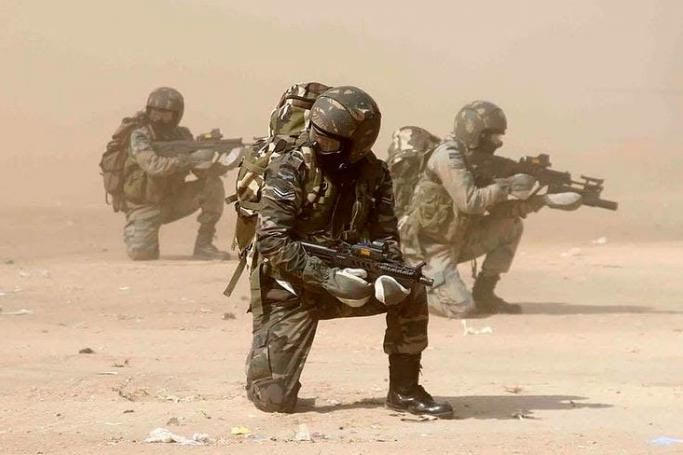The 9 June cross-border strikes by the Army on insurgents inside Myanmar may have had less impact on their military capacity than early assessments had indicated, official sources told The Indian Express on 11 June.
According to assessments being conducted by the Army with Intelligence services, just seven bodies have been recovered so far and wireless intercepts suggest less than a dozen insurgents were injured.
Moreover, the targets, one camp in Onzia and two adjacent camps in Ponyo, did not hit perpetrators of the June 4 ambush that killed 18 Army personnel, said a senior military intelligence official who is involved in collating these assessments.
“These camps were chosen for reasons of tactical viability, rather than specific retaliatory intent,” said the official, “given the short time frame available…the main idea was to deliver a message that camps across the border were not safe for anyone.”
The special forces went almost 11 km inside Myanmar, 5 km farther than what had been initially planned.
One camp destroyed in Ponyo was being led by Niki Sumi, self-styled “Lt General” of the NSCN-K (on the Indian side). But Sumi and an estimated 40 cadres of the group are said to have left the camp before the strike, an official said.
The latest assessments come even as intelligence services have reported that the 20-member squad responsible for the June 4 attack on the Army may have made its way across the Myanmar border back to its rear base at Tamu.
The Army has made no official claim on casualties. Army headquarters officials had said, in background briefings, that their casualty estimates stand at 20 dead and 11 injured. There were also claims that over 100 insurgents had been killed.
Photographs of the killed insurgents — required to be recorded in military counter-insurgency operations within India — have not been released.
Two separate military officials said the more lethal strike targeted the Onzia camp unconnected to the
National Socialist Council of Nagalim-Khaplang group or the Kanglei Yawol Kanna Lup, the two organisations which claimed responsibility for the campaign.
Indian intelligence had reported since at least 2010 the Onzia camp used to house the so-called 253 Mobile Battalion of the People’s Liberation Army of Manipur since at least 2010. The camp, Manipur Police sources said, operated mainly to extort funds from traffickers and traders.
Founded in 1978, the ethic-Meitei PLA is known to have received support from the NSCN-K, but is not thought to have been involved in the June 4 ambush.
The camp at Onzia, interestingly, did not figure in a 2013 list of major insurgent camps in Myanmar prepared for the Ministry of Home Affairs. An Army spokesperson said that the Army was aware the camp did not house NSCN-K personnel but added that the target was an umbrella of organisations rather than a specific group.
The second Army attack targeted two adjacent NSCN-K facilities at Ponyo, near the Myanmar town of Lahe, just across the border from the Mon district in Nagaland. The camp, across the border, described by Nagaland Police officials as a relatively minor facility, served as a launch pad for NSCN-K movement into the state from its rear bases around Taga, in Myanmar’s Sagaing Division.
“Though high-profile strikes like these play well on television”, said Ajai Sahni, the Director of the Institute of Conflict Management, “experience from across the world has taught us that they generally prove ephemeral, unless followed up by a sustained campaign to consistently degrade terrorist infrastructure”.
“The attack was a tactical success,” Sahni added, “but by itself, its strategic value is exactly zero.”
S SKhaplang, the aging patriarch of the NSCN-K, has been missing from the organisation’s main base at Taga for several months, and is rumoured to be undergoing medical treatment in Yangon. Intelligence on NSCN-K commanders, however appears to suggest that the group is planning further strikes, military sources said.
Life in the NSCN’s camps around Taga, a senior military source said, appeared to be largely normal, with no signs that groups had begun to disperse in anticipation of further attacks.
Sources said that Khaplangis said to have approached the Myanmar authorities for “protection of his cadres” as they were residents of the country.
You are viewing the old site.
Please update your bookmark to https://eng.mizzima.com.
Mizzima Weekly Magazine Issue...
14 December 2023
Spring Revolution Daily News f...
13 December 2023
New UK Burma sanctions welcome...
13 December 2023
Spring Revolution Daily News f...
12 December 2023
Spring Revolution Daily News f...
11 December 2023
Spring Revolution Daily News f...
08 December 2023
Spring Revolution Daily News f...
07 December 2023
Diaspora journalists increasin...
07 December 2023












